同位语和主语和名词性从句详解
- 格式:doc
- 大小:119.00 KB
- 文档页数:6
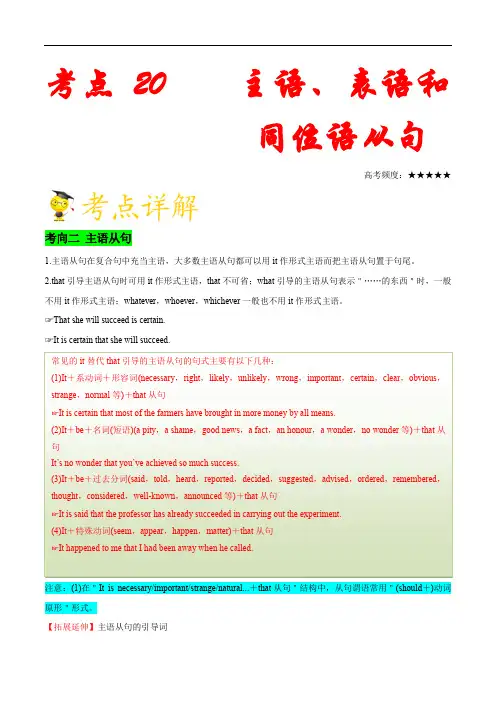
考点20 主语、表语和同位语从句高考频度:★★★★★考向二主语从句1.主语从句在复合句中充当主语,大多数主语从句都可以用it作形式主语而把主语从句置于句尾。
2.that引导主语从句时可用it作形式主语,that不可省;what引导的主语从句表示"……的东西"时,一般不用it作形式主语;whatever,whoever,whichever一般也不用it作形式主语。
☞That she will succeed is certain.☞It is certain that she will succeed.注意:(1)在"It is necessary/important/strange/natural...+that从句"结构中,从句谓语常用"(should+)动词原形"形式。
【拓展延伸】主语从句的引导词常见的it替代that引导的主语从句的句式主要有以下几种:(1)It+系动词+形容词(necessary,right,likely,unlikely,wrong,important,certain,clear,obvious,strange,normal等)+that从句☞It is certain that most of the farmers have brought in more money by all means.(2)It+be+名词(短语)(a pity,a shame,good news,a fact,an honour,a wonder,no wonder等)+that从句It’s no wonder that you’ve achieved so much success.(3)It+be+过去分词(said,told,heard,reported,decided,suggested,advised,ordered,remembered,thought,considered,wellknown,announced等)+that从句☞It is said that the professor has already succeeded in carrying out the experiment.(4)It+特殊动词(seem,appear,happen,matter)+that从句☞It happened to me that I had been away when he called.【特别注意】当作主语的句子太长时,为保持句子平衡,常用it作形式主语,而将真正的主语置后。
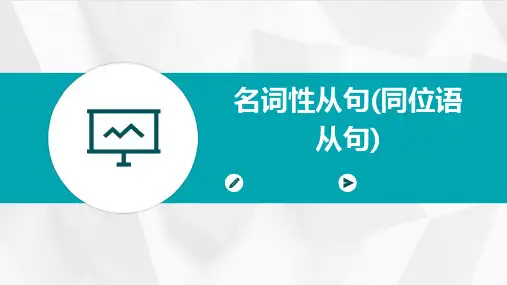
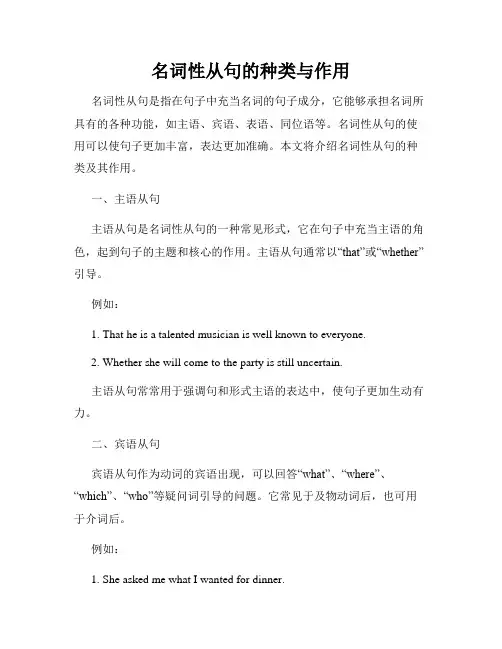
名词性从句的种类与作用名词性从句是指在句子中充当名词的句子成分,它能够承担名词所具有的各种功能,如主语、宾语、表语、同位语等。
名词性从句的使用可以使句子更加丰富,表达更加准确。
本文将介绍名词性从句的种类及其作用。
一、主语从句主语从句是名词性从句的一种常见形式,它在句子中充当主语的角色,起到句子的主题和核心的作用。
主语从句通常以“that”或“whether”引导。
例如:1. That he is a talented musician is well known to everyone.2. Whether she will come to the party is still uncertain.主语从句常常用于强调句和形式主语的表达中,使句子更加生动有力。
二、宾语从句宾语从句作为动词的宾语出现,可以回答“what”、“where”、“which”、“who”等疑问词引导的问题。
它常见于及物动词后,也可用于介词后。
例如:1. She asked me what I wanted for dinner.2. He told me where he had been yesterday.宾语从句的作用是充当动词的宾语,使句子更加完整,表达更加准确。
三、表语从句表语从句用来修饰名词或代词,充当表语的角色,常以“that”或“whether”引导。
表语从句通常出现在“be”动词后或感官动词后。
例如:1. The question is whether we should go or stay.2. His wish is that he could travel around the world.表语从句可以在句中起到进一步解释、说明或补充的作用,使句子更加丰富多样。
四、同位语从句同位语从句指的是对名词或代词进行解释、说明或补充的句子,常见于名词后面,起到进一步解释名词的作用。
同位语从句通常以“that”引导。
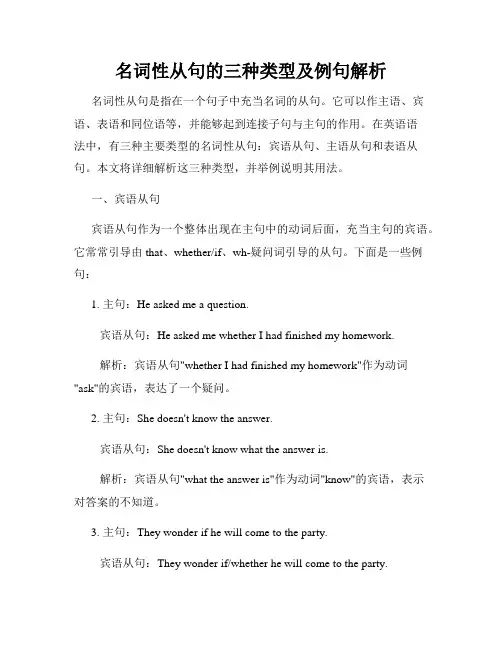
名词性从句的三种类型及例句解析名词性从句是指在一个句子中充当名词的从句。
它可以作主语、宾语、表语和同位语等,并能够起到连接子句与主句的作用。
在英语语法中,有三种主要类型的名词性从句:宾语从句、主语从句和表语从句。
本文将详细解析这三种类型,并举例说明其用法。
一、宾语从句宾语从句作为一个整体出现在主句中的动词后面,充当主句的宾语。
它常常引导由that、whether/if、wh-疑问词引导的从句。
下面是一些例句:1. 主句:He asked me a question.宾语从句:He asked me whether I had finished my homework.解析:宾语从句"whether I had finished my homework"作为动词"ask"的宾语,表达了一个疑问。
2. 主句:She doesn't know the answer.宾语从句:She doesn't know what the answer is.解析:宾语从句"what the answer is"作为动词"know"的宾语,表示对答案的不知道。
3. 主句:They wonder if he will come to the party.宾语从句:They wonder if/whether he will come to the party.解析:宾语从句"if/whether he will come to the party"作为动词"wonder"的宾语,表达了对他是否会来参加派对的疑问。
二、主语从句主语从句作为一个整体出现在句子的最前面,充当主句的主语。
它通常由that引导,也可以由wh-疑问词引导。
以下是一些例句:1. 主句:It is important to learn a foreign language.主语从句:That she is a hardworking student is important.解析:主语从句"That she is a hardworking student"作为句子的主语,强调了她是一个勤奋的学生的重要性。
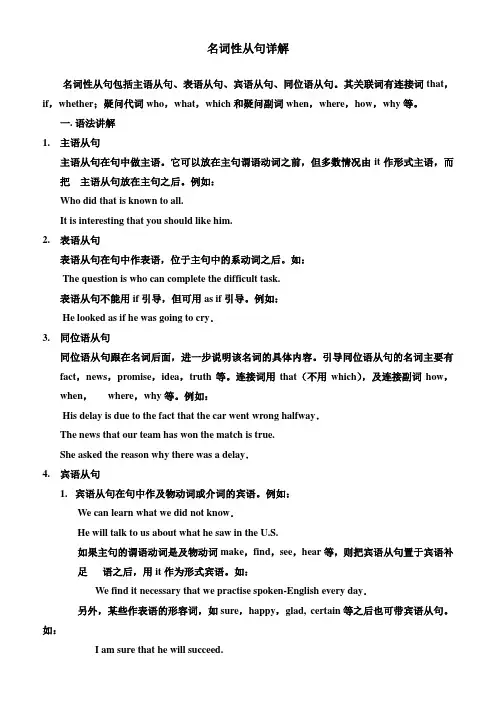
名词性从句详解名词性从句包括主语从句、表语从句、宾语从句、同位语从句。
其关联词有连接词that,if,whether;疑问代词who,what,which和疑问副词when,where,how,why等。
一.语法讲解1.主语从句主语从句在句中做主语。
它可以放在主句谓语动词之前,但多数情况由it作形式主语,而把主语从句放在主句之后。
例如:Who did that is known to all.It is interesting that you should like him.2.表语从句表语从句在句中作表语,位于主句中的系动词之后。
如:The question is who can complete the difficult task.表语从句不能用if引导,但可用as if引导。
例如:He looked as if he was going to cry.3.同位语从句同位语从句跟在名词后面,进一步说明该名词的具体内容。
引导同位语从句的名词主要有fact,news,promise,idea,truth等。
连接词用that(不用which),及连接副词how,when,where,why等。
例如:His delay is due to the fact that the car went wrong halfway.The news that our team has won the match is true.She asked the reason why there was a delay.4.宾语从句1.宾语从句在句中作及物动词或介词的宾语。
例如:We can learn what we did not know.He will talk to us about what he saw in the U.S.如果主句的谓语动词是及物动词make,find,see,hear等,则把宾语从句置于宾语补足语之后,用it作为形式宾语。
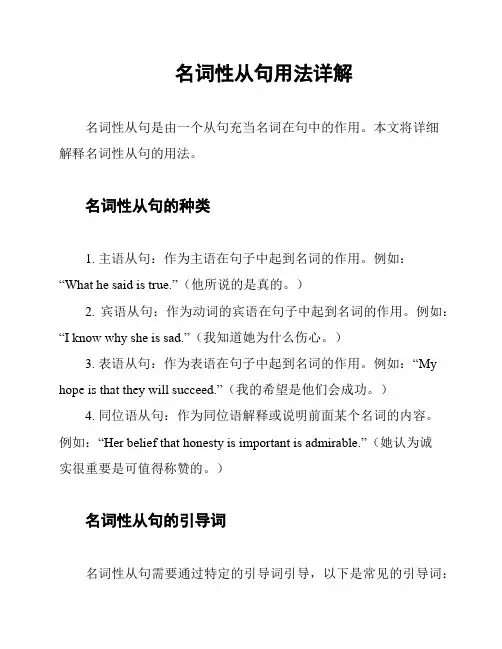
名词性从句用法详解名词性从句是由一个从句充当名词在句中的作用。
本文将详细解释名词性从句的用法。
名词性从句的种类1. 主语从句:作为主语在句子中起到名词的作用。
例如:“What he said is true.”(他所说的是真的。
)2. 宾语从句:作为动词的宾语在句子中起到名词的作用。
例如:“I know why she is sad.”(我知道她为什么伤心。
)3. 表语从句:作为表语在句子中起到名词的作用。
例如:“My hope is that they will succeed.”(我的希望是他们会成功。
)4. 同位语从句:作为同位语解释或说明前面某个名词的内容。
例如:“Her belief that honesty is important is admirable.”(她认为诚实很重要是可值得称赞的。
)名词性从句的引导词名词性从句需要通过特定的引导词引导,以下是常见的引导词:1. 主语从句引导词:that, whether, who, whom, whose, what, which, whoever, whomever, whichever, whatever(例如:I think that he is right.)2. 宾语从句引导词:that, whether, if, who, whom, whose, what, which(例如:I don't know what she wants.)名词性从句的用法注意事项1. 在主语从句中,当从句与主句的主语指代相同时,可以省略引导词that(例如:What he said is true.)2. 在宾语从句中,当从句的主语与主句的宾语指代相同时,可以省略引导词that和主语(例如:I know what she wants.)以上是对名词性从句用法的详细解释,希望对您有所帮助。
(字数:180)。
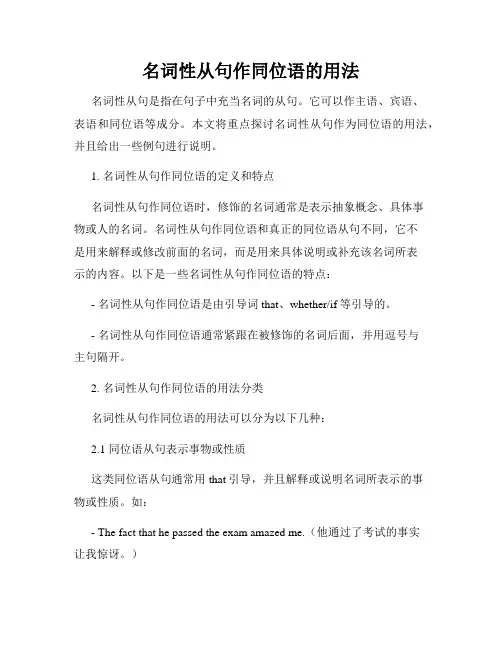
名词性从句作同位语的用法名词性从句是指在句子中充当名词的从句。
它可以作主语、宾语、表语和同位语等成分。
本文将重点探讨名词性从句作为同位语的用法,并且给出一些例句进行说明。
1. 名词性从句作同位语的定义和特点名词性从句作同位语时,修饰的名词通常是表示抽象概念、具体事物或人的名词。
名词性从句作同位语和真正的同位语从句不同,它不是用来解释或修改前面的名词,而是用来具体说明或补充该名词所表示的内容。
以下是一些名词性从句作同位语的特点:- 名词性从句作同位语是由引导词that、whether/if等引导的。
- 名词性从句作同位语通常紧跟在被修饰的名词后面,并用逗号与主句隔开。
2. 名词性从句作同位语的用法分类名词性从句作同位语的用法可以分为以下几种:2.1 同位语从句表示事物或性质这类同位语从句通常用that引导,并且解释或说明名词所表示的事物或性质。
如:- The fact that he passed the exam amazed me.(他通过了考试的事实让我惊讶。
)- It's a pity that the project was canceled.(项目被取消是个遗憾。
)2.2 同位语从句表示人或身份这类同位语从句通常用that或whether/if引导,并且说明名词所表示的人或身份。
如:- I heard that she is a famous writer.(我听说她是一位著名的作家。
)- My mother doubted whether he is telling the truth.(我妈妈怀疑他是否在说真话。
)2.3 同位语从句表示观点或信念这类同位语从句通常用that引导,并且说明名词所表示的观点或信念。
如:- We all have the same belief that hard work pays off.(我们都有一个共同的信念,那就是努力会有回报。
)- His opinion that we should study abroad is shared by many students.(他认为我们应该出国留学的观点得到了许多学生的赞同。
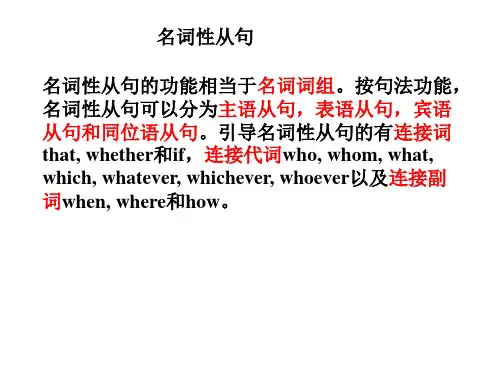
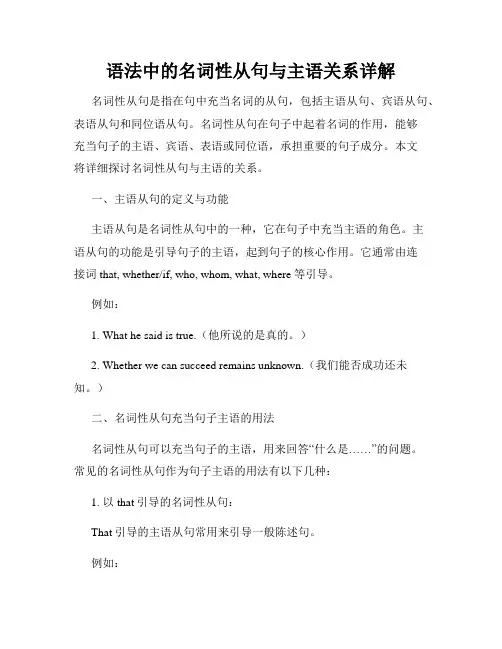
语法中的名词性从句与主语关系详解名词性从句是指在句中充当名词的从句,包括主语从句、宾语从句、表语从句和同位语从句。
名词性从句在句子中起着名词的作用,能够充当句子的主语、宾语、表语或同位语,承担重要的句子成分。
本文将详细探讨名词性从句与主语的关系。
一、主语从句的定义与功能主语从句是名词性从句中的一种,它在句子中充当主语的角色。
主语从句的功能是引导句子的主语,起到句子的核心作用。
它通常由连接词that, whether/if, who, whom, what, where等引导。
例如:1. What he said is true.(他所说的是真的。
)2. Whether we can succeed remains unknown.(我们能否成功还未知。
)二、名词性从句充当句子主语的用法名词性从句可以充当句子的主语,用来回答“什么是……”的问题。
常见的名词性从句作为句子主语的用法有以下几种:1. 以that引导的名词性从句:That引导的主语从句常用来引导一般陈述句。
例如:That he is not here worries me.(他不在这里让我很担心。
)2. 以wh-词引导的名词性从句:Wh-词引导的主语从句常用来引导疑问句,表示“什么是……”。
例如:What he said surprised me.(他说的话让我很吃惊。
)3. 以whether/if引导的名词性从句:Whether/if引导的主语从句用来表示“是否是……”。
例如:Whether/if he will come is uncertain.(他是否会来是不确定的。
)三、主语从句的位置与意义主语从句位于句子的主谓之间,起到引导整个句子的作用。
主语从句在句子中常常与其他成分发生一定的替换关系,这为句子的多样性和灵活性提供了可能。
例如:1. It is important to study hard.(努力学习很重要。
)主语从句的目的是陈述句子的主题,通过it位于句首,句子更加流畅自然。
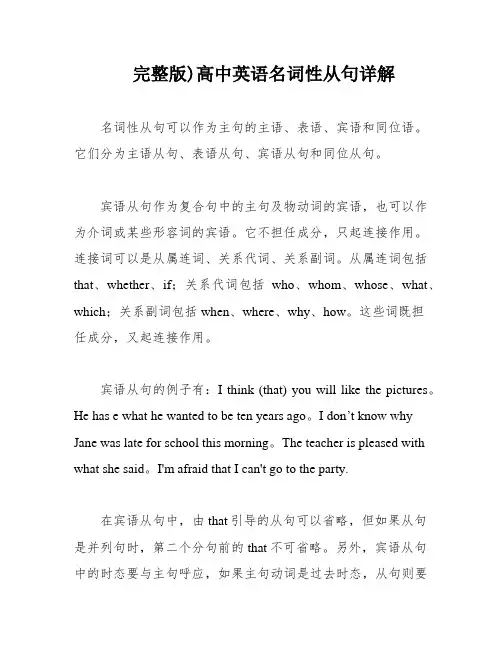
完整版)高中英语名词性从句详解名词性从句可以作为主句的主语、表语、宾语和同位语。
它们分为主语从句、表语从句、宾语从句和同位从句。
宾语从句作为复合句中的主句及物动词的宾语,也可以作为介词或某些形容词的宾语。
它不担任成分,只起连接作用。
连接词可以是从属连词、关系代词、关系副词。
从属连词包括that、whether、if;关系代词包括who、whom、whose、what、which;关系副词包括when、where、why、how。
这些词既担任成分,又起连接作用。
宾语从句的例子有:I think (that) you will like the pictures。
He has e what he wanted to be ten years ago。
I don’t know why Jane was late for school this morning。
The teacher is pleased with what she said。
I'm afraid that I can't go to the party.在宾语从句中,由that引导的从句可以省略,但如果从句是并列句时,第二个分句前的that不可省略。
另外,宾语从句中的时态要与主句呼应,如果主句动词是过去时态,从句则要用相应的过去时态。
如果从句表示的是客观真理、科学原理或自然现象,从句仍用现在时态。
如果主语谓语动词为think、consider、suppose、believe、expect、guess、imagine等,其后的宾语从句若含有否定意义,一般要把否定词转移到主句谓语上,从句谓语用肯定式。
XXX。
It is often said that traveling broadens the mind。
I XXX I was determined to carry out the plan。
I consider it XXX。

英语语法讲义-名词性从句一、概说名词性从句,即指具有名词性质的从句,它包括主语从句、宾语从句、表语从句和同位语从句。
名词性从句是高中英语学习中的一个语法重点,也是历年高考重点考查的内容之一。
学习名词性从句主要应注意其引导词的用法与区别,从句的词序以及名词性从句与其他从句的区别等。
二、主语从句1.主语从句的引导词主语从句通常由连词that和whether、连接代词或连接副词以及关系代词型what引导:That he is still alive is a wonder. 他还活着,真是奇迹。
W hen we arrive doesn’t matter. 什么时候到没有关系。
What we need is money. 我们需要的是钱。
What I want to know is this. 我想知道的就是这一点。
Whether they would support us was a problem. 他们是否会支持我们还是一个问题。
2.主语从句与形式主语it有时为了考虑句子平衡,通常在主语从句处使用形式主语it,而将真正的主语从句移至句末。
这分三种情况:(1)对于以连词that引导的主语从句,通常用形式主语代主语从句:It’s a pity that he didn’t come. 很遗憾他没来。
(2)对于以连接代词(副词)引导的主语从句,可以使用形式主语代主语从句,也可直接在句首使用主语从句:Whether they would support us was a problem. 他们是否会支持我们还是一个问题。
It was a problem whether they would support us. 他们是否会支持我们还是一个问题。
(3)对关系代词型what引导的主语从句,通常不用形式主语,总是主语从句放在句首:What we need is money. 我们需要的是钱。
What I want to know is this. 我想知道的就是这一点。
《高中英语语法详细讲解》主语从句(3-5)、同位语从句(5-9)、表语从句(9-12)、定语从句(12-22)、非限制性定语从句(22-24)、状语从句(24-37)一、名词性从句百科名片在句子中起名词作用的句子叫名词性从句 (Noun Clauses)。
名词性从句的功能相当于名词词组, 它在复合句中能担任主语、宾语、表语、同位语、介词宾语等,因此根据它在句中不同的语法功能,名词性从句又可分别称为主语从句、宾语从句、表语从句和同位语从句。
名词性从句高考热点透视1. ___ is a fact that English is being accepted as an international language. (NMET 1995)A. ThereB. ThisC. ThatD. It答案D。
当名词从句在句中作主语时,为避免句子头重脚轻,常用it作形式主语置于句首,而将真正的主语从句放在句尾。
此时it只起先行引导作用,本身无实义。
此句也可以改写为:That English is being accepted as an international language is a fact.2.A computer can only do ____ you have instructed it to do.(NMET2001)A.how B.after C.what D.when答案C。
从句子结构可知,句子的空白处应该填引导宾语从句的连词,做主句谓语动词do的宾语,同时该连接词还是从句中的do的宾语,因此,此处的连接词应该用what。
3. He asked ____ for a violin.(MET1992)A. did I pay how muchB. I paid how muchC. how much did I payD. how much I paid答案:D。
宾语从句相当于特殊疑问句,句子语序要用陈述语序。
名词性从句的语法结构详解名词性从句是从句在句中充当名词的作用。
它可以在句子中充当主语、宾语、表语或同位语,并起到衔接句子结构的作用。
在英语语法中,名词性从句有三种类型:主语从句、宾语从句和表语从句。
本文将详细介绍这三种名词性从句的语法结构。
1. 主语从句主语从句在句中作主语,用来引导主句的动作或状态。
主语从句一般由连接词 that 引导,也可以由连接词 whether 或 if 来引导。
以下是几个例子:- That he is innocent is obvious. (他无辜是显而易见的。
)- If it rains, we will stay indoors. (如果下雨,我们会呆在室内。
)2. 宾语从句宾语从句在句中作宾语,用来接受主句动作的影响或承载主句的意义。
宾语从句一般由连接词 that 引导,也可以由连接词whether 或 if 来引导。
以下是几个例子:- He said that he loves her. (他说他爱她。
)- She asked if I had finished my homework. (她问我是否完成了我的作业。
)3. 表语从句表语从句在句中作表语,用来给主语指定属性或状态。
表语从句一般由连接词 that 引导,也可以由连接词 whether 或 if 来引导。
以下是几个例子:- The fact that he lost the game is disappointing. (他输掉比赛的事实令人失望。
)- His biggest concern is whether the project will be successful. (他最大的担忧是这个项目是否会成功。
)- Her hope is that she can travel the world. (她的希望是能够环游世界。
)总结名词性从句是英语语法中重要的语法结构之一,用于引导从句充当句子成分。
同位语从句是名词性从句(主语从句、表语从句、宾语从句、同位语从句,介宾从句)中的主要从句之一,从句作同位语表示与之同位的名词(短语)的实际内容,它的作用相当于名词,对前面的名词(短语)加以补充说明或进一步解释,相当于一个表语从句,它们之间的关系是同位关系,即主表关系。
类型:1、名词作同位语:Mr Wang,my child’s teacher,will be visiting us on Tuesday.2、句子作同位语:The girls were surprised at the fact that ocean ships can sail up the Great lakes.巨大的海轮可以开到五大湖,让女孩们感到吃惊。
3、直接引语作同位语:But now the question comes to their minds,“Did she die young because she was a clone?”但是现在他们不得不思考这样的问题:“多莉早死是因为它是一只克隆羊吗?”用法:1、可以跟同位语从句的名词通常有news,idea,fact,promise,question,doubt,thought,hope,message,suggestion,words(消息),possibility等(一般的“抽象”名词都可用)。
I’ve come from Mr wang with a message that he won’t be able to see you this afternoon.2、英语中引导同位语从句的词通常有连词that,whether,连接代词what,who。
连接副词how,when,where等。
(注:if,which 不能引导同位语从句。
)He must answer the question whether he agrees to it or not.3、有时同位语从句可以不紧跟在说明的名词后面,而被别的词隔开叫做间隔同位语从句。
由于that从句太长,为避免句子失去平衡, The thought came to him that maybe the enemy had fled the city.他突然想起可能敌人已经逃出城了。
具体分析:1、连词that引导(注:引导同位语从句的that不能省略)The idea that you can do this work well without thinking is quite wrong.【注】在某些名词(如demand,wish,suggestion,resolution等)后面的同位语从句要用虚拟语气。
There was a suggestion that Brown should be dropped from(离开) the team. 【注】引导同位语从句的连词that通常不省略,但在非正式文体中也可以省去。
He gabbed his suitcase and gave the impression he was boarding the Tokyo plane. 他拿起了手提箱,给人的印象是他要登上飞往东京的飞机了。
2、连词whether引导(注:if不能引导同位语从句) The question whether we should call in a specialist was answered by the family doctor. 我们是否请专家由家庭医生来定。
3、连接副词引导连接副词when,where,how,whyWe haven’t yet settled the questi on where we are going to spend our summer vacation.4、其它引导词引导连接代词what,who,whom,whose,引导同位语从句1).I have no idea what size shoes she wears.2).The question who will take his place is still not clear.5、先行词1.定语从句的先行词是名词或代词;而同位语从句的先行词只能是名词(有特殊情况,见下面),而且仅限于idea,plan,fact,theory,promise,hope,news,doubt,truth,information,suggestion,question, thought,belief,conclusion等少数名词。
2.when,where,why引导的定语从句的先行词一定分别是表示时间、地点和原因的名词,而三者引导的同位语从句的先行词则肯定不是表示时间、地点和原因的名词。
①I still remember the day when I first came to Beijing.②I have no idea when she will be back.引导词: 1.定语从句和同位语从句共同的引导词有四个:that,when,where,why。
总结四个引导词在两种从句中的不同用法。
(课下)2.what,how,whatever 等可引导同位语从句,但不引导定语从句。
代词it可用作同位语从句的先行词。
这个it常放在某些动词或短语动词后作宾语,同时兼作其后that同位语从句的先行词。
I owe it to you that I am still alive. 幸亏你,我现在还活着。
主语从句:在复合句中充当主语成分的句子叫做主语从句。
主语从句的时态不受主句的时态影响和限制。
具体如下:(1)引导主语从句连词有that,whether,who,what,whatever等(2)连词位于句首不能省略(3)主语从句大多数情况下视为第三人称单数,但也有例外,当what引导的名词性分句作主语时,主谓一致问题极为复杂。
1.That he finished writing the composition in such a short time surprised us all.2. Whether we will go for an outing tomorrow remains unknown.去郊游;去远足3. Who will be our monitor hasn't been decided yet.4. Whom we must study for is a question of great importance.5. What we need are good doctors.6. Whatever you did is right.为了防止句子头重脚轻,通常把形式主语it放在句首位置,真正主语搁置于句末It is important that we all should attend the meeting. It+形式主语谓语+从句。
另外,还有一些比较多见的结构:It turned out that…; It has been proved that……; It happened/occurred that……; It is well-known that……等等用it 作形式主语的结构:(1) It is +名词+that从句It is a fact that ... 事实是 (2)it is +形容词+that从句It is strange that… 奇怪的是…(3) it +不及物动词+that 从句It seems that… 似乎…(4) it is+过去分词+that从句It is reported that… 据报道…It 作形式主语和it引导强调句的比较:1.主语从句常用it作形式主语,一般常用句型为:It is+{名词/形容词/过去分词}+主语从句例: It is still a question whether she will come or not.2.强调句不同,它的结构是:It+be+被强调部分+that+从句强调主语:It is the times that produce their heroes.时势造英雄强调宾语:It is English that Jack teaches us.强调状语:It was in shanghai that I saw the film.判断是否是强调句方法:将that以后的“句子的其余部分”拿出来单独看,看有没有缺成分,缺的是什么成分,再把谓语动词后面that前面的那部分,带到认为缺成分的地方,如果放进去是一句完整的句子了,那就说明是强调句。
主语从句不可位于句首的五种情况(1) if 引导的主语从句不可居于复合句句首。
(2) It is said , (reported) …结构中的主语从句不可提前。
(3) It happens…, It occurs… 结构中的主语从句不可提前。
例如:It occurred to him that he failed in the examination.(4) It doesn’t matter how/whether …结构中的主语从句不可提前。
例如:It doesn’t matter whether he is wrong or not.(5) 含主语从句的复合句是疑问句时,主语从句不可提前。
例如:Is it likely that it will rain in the evening?What 与that 在引导主语从句时的区别:What 引导主语从句时在从句中充当句子成分,如主语.宾语.表语,而that 则不然。
宾语从句区分主语从句的几个特征:宾语从句必须是用陈述语句。
名词性从句:1.在句子中起名词作用的句子叫名词性从句。
在复合句中能担任主语、宾语、表语、同位语、介词宾语(介词宾语,就是放在介词后面的名词、名词短语、甚至宾语从句,或者一些代词。
you do not need to worry about this problem.)等,名词性从句又可分别称为主语从句、宾语从句、表语从句和同位语从句。
2.引导名词性从句的连接词可分为三类:3.连词(5个):that (宾语从句或表语从句中"that"有时可以省略)whether,if (均表示“是否”表明从句内容的不确定性)as if ,as though (均表示“好像”,“似乎”)以上在从句中均不充当任何成分。
4.连接代词(10个):what, whatever, who, whoever, whom, whomever, whose,whosever,which, whicheve5.连接副词(7个):when, where, how, why, whenever, wherever, however不可省略的连词:1. 介词后的连词。